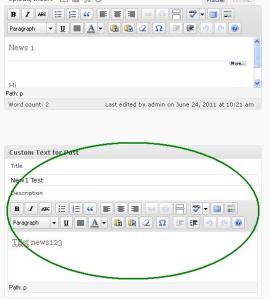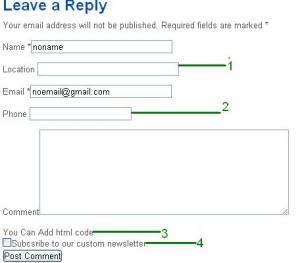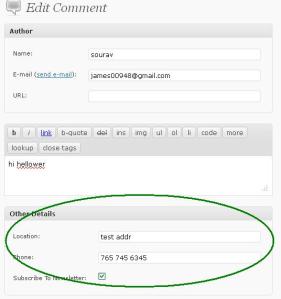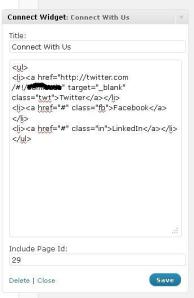Add field to media edit form
24th Jun 2011 at 10:14 AM | Posted in Wordpress | 3 Comments
<?php
// hook media edit form
add_filter("attachment_fields_to_edit", "my_image_attachment_fields_to_edit", null, 2); add_filter("attachment_fields_to_save", "my_image_attachment_fields_to_save", null, 2); function my_image_attachment_fields_to_edit($form_fields, $post) { // $form_fields is a special array of fields to include in the attachment form // $post is the attachment record in the database // $post--->post_type == 'attachment'
// (attachments are treated as posts in WordPress)
// add our custom field to the $form_fields array
// input type="text" name/id="attachments[$attachment->ID][custom1]"
$checked = get_post_meta($post->ID, "_is_photo_gallery", true);
if($checked){
$is_checked="checked";
}else{
$is_checked='';
}
$form_fields["is_photo_gallery"] = array(
"label" => __("Show In Photo Gallery"),
"input" => "html", // this is default if "input" is omitted
"html" => "<input id="attachments[{$post->ID}][is_photo_gallery]" type="checkbox" name="attachments[{$post->ID}][is_photo_gallery]" value="1" />"
);
// if you will be adding error messages for your field,
// then in order to not overwrite them, as they are pre-attached
// to this array, you would need to set the field up like this:
//$form_fields["custom1"]["label"] = __("Custom Text Field");
//$form_fields["custom1"]["input"] = "text";
//$form_fields["custom1"]["value"] = get_post_meta($post->ID, "_custom1", true);
return $form_fields;
}
function my_image_attachment_fields_to_save($post, $attachment) {
// $attachment part of the form $_POST ($_POST[attachments][postID])
// $post attachments wp post array - will be saved after returned
// $post['post_type'] == 'attachment'
if( isset($attachment['is_photo_gallery']) ){
// update_post_meta(postID, meta_key, meta_value);
update_post_meta($post['ID'], '_is_photo_gallery', $attachment['is_photo_gallery']);
}
return $post;
}
?>
Output:
Add field to post/page edit form
24th Jun 2011 at 10:12 AM | Posted in Wordpress | 6 Comments
<?php
//hook admin edit page
add_action( 'add_meta_boxes', 'myplugin_add_custom_box' );
//save data
add_action( 'save_post', 'myplugin_save_postdata' );
/* Adds a box to the main column on the Post and Page edit screens */
function myplugin_add_custom_box() {
add_meta_box(
'myplugin_sectionid',
__( 'Custom Text for Post', 'myplugin_customtext' ),
'myplugin_inner_custom_box',
'post'
);
add_meta_box(
'myplugin_sectionid',
__( 'Custom Text for Page', 'myplugin_customtext' ),
'myplugin_inner_custom_box',
'page'
);
}
/* Prints the box content */
function myplugin_inner_custom_box() {
// Use nonce for verification
wp_nonce_field( plugin_basename( __FILE__ ), 'myplugin_noncename' );
global $post;
$myplugin_customtext = get_post_meta($post->ID,'myplugin_customtext',true);
$myplugin_description = get_post_meta($post->ID,'myplugin_description',true);
// The actual fields for data entry
echo '<p><label for="myplugin_new_field">';
_e("Title", 'myplugin_customtext' );
echo '</label></p>';
echo '<div><input type="text" id="myplugin_customtext" name="myplugin_customtext" value="'.$myplugin_customtext.'" size="25" style="width:100%;" /></div>';
echo '<p><label for="myplugin_new_field">';
_e("Description", 'myplugin_customtext' );
echo '</label></p>';
echo '<div style="border:1px solid #DFDFDF;"><textarea id="myplugin_description" name="myplugin_description">'.$myplugin_description.'</textarea></div>';
?>
<script type="text/javascript">
jQuery(document).ready(function() {
jQuery("#myplugin_description").addClass("mceEditor");
if ( typeof( tinyMCE ) == "object" && typeof( tinyMCE.execCommand ) == "function" ) {
tinyMCE.execCommand("mceAddControl", true, "myplugin_description");
}
});
</script>
<?php
}
function myplugin_save_postdata( $post_id ) {
// verify if this is an auto save routine.
// If it is our form has not been submitted, so we dont want to do anything
if ( defined( 'DOING_AUTOSAVE' ) && DOING_AUTOSAVE )
return;
// verify this came from the our screen and with proper authorization,
// because save_post can be triggered at other times
if ( !wp_verify_nonce( $_POST['myplugin_noncename'], plugin_basename( __FILE__ ) ) )
return;
// Check permissions
if ( 'page' == $_POST['post_type'] )
{
if ( !current_user_can( 'edit_page', $post_id ) )
return;
}
else
{
if ( !current_user_can( 'edit_post', $post_id ) )
return;
}
// OK, we're authenticated: we need to find and save the data
$myplugin_customtext = $_POST['myplugin_customtext'];
$myplugin_description = $_POST['myplugin_description'];
update_post_meta($post_id, "myplugin_customtext", $myplugin_customtext);
update_post_meta($post_id, "myplugin_description", $myplugin_description);
// Do something with $mydata
// probably using add_post_meta(), update_post_meta(), or
// a custom table (see Further Reading section below)
return true;
}
?>
Custom Comment Form in WordPress
24th Jun 2011 at 10:08 AM | Posted in Wordpress | 6 Comments
<?php
// get defaults
add_filter('comment_form_defaults','mytheme_comments_form_defaults');
// get default fields
add_filter( 'comment_form_default_fields', 'comment_fields' );
// save extra fields in database
add_action( 'comment_post', 'save_comment' );
function mytheme_comments_form_defaults($default) {
$default['comment_notes_after'] = 'You Can Add html code<br/><input type="checkbox" name="is_newsletter" id="is_newsletter" value="1"/>Subcsribe to our custom newsletter.<br/>';
//unset($default['comment_notes_after']);
return $default;
}
function comment_fields($fields)
{
global $current_user;
if(is_user_logged_in()){
get_currentuserinfo();
$phone = get_usermeta($current_user->ID,'business_phone');
$address = get_usermeta($current_user->ID,'address');
}
$fields['url'] = '';
$fields['location'] = '<p class="comment-form-location">' . '<label for="location">' . __( 'Location' ) . '</label> ' .
'<input id="location" name="location" type="text" value="' . esc_attr( $address ) . '" size="30" /></p>';
$fields['phone'] = '<p class="comment-form-phone">' . '<label for="phone">' . __( 'Phone' ) . '</label> ' .
'<input id="phone" name="phone" type="text" value="' . esc_attr( $phone ) . '" size="20" /></p>';
$fields = array( $fields['author'], $fields['location'], $fields['email'], $fields['phone'], $fields['url'] );
return $fields;
}
function save_comment($comment_id)
{
add_comment_meta( $comment_id, 'location', $_POST['location'], true );
add_comment_meta( $comment_id, 'phone', $_POST['phone'], true );
add_comment_meta( $comment_id, 'is_newsletter', $_POST['is_newsletter'], true );
}
?>
Output:
Now Show the fields in admin section
<?php
//hook comment listing page
add_action('comment_text', 'show_commeta');
//hook edit comment
add_action( 'add_meta_boxes_comment', 'page_comments_status_meta_box' );
// save comment meta
add_action('edit_comment','save_markdown_after_edit');
if (is_admin()) {
echo get_comment_text(), '<br/><span style="color:blue;">', get_comment_meta(get_comment_ID(), 'location',1).'</span>';
}}
function page_comments_status_meta_box($post){
$location = get_comment_meta($post->comment_ID,"location",true);
$phone = get_comment_meta($post->comment_ID,"phone",true);
$is_newsletter = get_comment_meta($post->comment_ID,"is_newsletter",true);
if($post->user_id && ($location=='' && $phone=='')){
$location = get_user_meta($post->user_id,"address",true);
$phone = get_user_meta($post->user_id,"business_phone",true);
}
?>
<div class="stuffbox" id="namediv">
<h3><label for="name">Other Details</label></h3>
<div class="inside">
<table class="form-table">
<tr valign="top">
<td class="first">Location:</td>
<td><input type="text" id="location" tabindex="5" value="<?php echo $location; ?>" size="30" name="location"></td>
</tr>
<tr valign="top">
<td class="first">
Phone:</td>
<td><input type="text" id="phone" tabindex="2" value="<?php echo $phone; ?>" size="20" name="phone"></td>
</tr>
<tr valign="top">
<td class="first">
Subscribe To Newsletter:</td>
<td align="left" style="float:left;"><input type="checkbox" id="is_newsletter" tabindex="2" value="1" name="is_newsletter"<?php if($is_newsletter)echo "checked";?>></td>
</tr>
</table>
<br>
</div>
</div>
<?php
}
function save_markdown_after_edit($comment_ID){
if (isset($_POST['location'])){
update_comment_meta($comment_ID,'location',$_POST['location']);
}if (isset($_POST['phone'])){
update_comment_meta($comment_ID,'phone',$_POST['phone']);
}
}
?>
WordPress Create Custom Widget
16th Jun 2011 at 1:30 PM | Posted in Wordpress | Leave a comment
<?php
/**
* Plugin Name: Connect With Us Widget
* Description: A widget that serves as an example for developing more advanced widgets.
* Version: 0.1
*
* This program is distributed in the hope that it will be useful,
* but WITHOUT ANY WARRANTY; without even the implied warranty of
* MERCHANTABILITY or FITNESS FOR A PARTICULAR PURPOSE.
*/
/**
* Add function to widgets_init that'll load our widget.
* @since 0.1
*/
add_action( 'widgets_init', 'connect_load_widgets' );
/**
* Register our widget.
* 'Example_Widget' is the widget class used below.
*
* @since 0.1
*/
function connect_load_widgets() {
register_widget( 'Connect_Widget' );
}
/**
* Example Widget class.
* This class handles everything that needs to be handled with the widget:
* the settings, form, display, and update. Nice!
*
* @since 0.1
*/
class Connect_Widget extends WP_Widget {
/**
* Widget setup.
*/
function Connect_Widget() {
/* Widget settings. */
$widget_ops = array( 'classname' => 'connect', 'description' => __('An socal medis widget.', 'connect') );
/* Widget control settings. */
$control_ops = array( 'width' => 300, 'height' => 350, 'id_base' => 'connect-widget' );
/* Create the widget. */
$this->WP_Widget( 'connect-widget', __('Connect Widget', 'connect'), $widget_ops, $control_ops );
}
/**
* How to display the widget on the screen.
*/
function widget( $args, $instance ) {
extract( $args );
global $post;
$include = $instance['include'];
$includeArr = array();
if($include != ''){
$includeArr = explode(",",$include);
}
if(is_page($includeArr)){
/* Our variables from the widget settings. */
$title = apply_filters('widget_title', $instance['title'] );
$name = $instance['name'];
$description = $instance['description'];
/* Before widget (defined by themes). */
echo $before_widget;
echo '<div class="cntSocial">';
/* Display the widget title if one was input (before and after defined by themes). */
if ( $title )
echo '<h3 class="widget-title">'. $title ."</h3>";
/* Display name from widget settings if one was input. */
if ( $description )
echo $description;
echo '<br class="clear" /></div>';
/* After widget (defined by themes). */
echo $after_widget;
}
}
/**
* Update the widget settings.
*/
function update( $new_instance, $old_instance ) {
$instance = $old_instance;
/* Strip tags for title and name to remove HTML (important for text inputs). */
$instance['title'] = $new_instance['title'];
$instance['description'] = $new_instance['description'];
$instance['include'] = $new_instance['include'];
return $instance;
}
/**
* Displays the widget settings controls on the widget panel.
* Make use of the get_field_id() and get_field_name() function
* when creating your form elements. This handles the confusing stuff.
*/
function form( $instance ) {
/* Set up some default widget settings. */
$defaults = array( 'title' => __('Connect', 'connect'), 'name' => __('John Doe', 'connect'), 'sex' => 'male', 'show_sex' => true );
$instance = wp_parse_args( (array) $instance, $defaults ); ?>
<!-- Widget Title: Text Input -->
<p>
<label for="<?php echo $this->get_field_id( 'title' ); ?>"><?php _e('Title:', 'hybrid'); ?></label>
<input id="<?php echo $this->get_field_id( 'title' ); ?>" name="<?php echo $this->get_field_name( 'title' ); ?>" value="<?php echo $instance['title']; ?>" style="width:100%;" class="widefat" />
</p>
<!-- Your Name: Text Input -->
<p>
<textarea id="<?php echo $this->get_field_id( 'description' ); ?>" name="<?php echo $this->get_field_name( 'description' ); ?>" class="widefat" cols="20" rows="16"><?php echo $instance['description']; ?></textarea>
</p>
<p>
<label for="<?php echo $this->get_field_id( 'include' ); ?>"><?php _e('Include Page Id:', 'hybrid'); ?></label>
<input id="<?php echo $this->get_field_id( 'include' ); ?>" name="<?php echo $this->get_field_name( 'include' ); ?>" value="<?php echo $instance['include']; ?>" style="width:100%;" class="widefat" />
</p>
<?php
}
}
?>
————————————————————-
Output:
Create a free website or blog at WordPress.com.
Entries and comments feeds.





